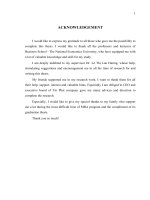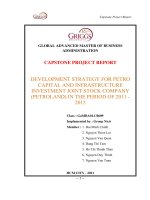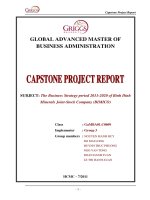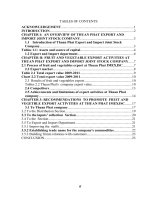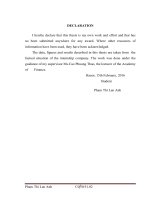16 ANALYZING THE FINANCIAL SITUATION IN TAN PHAT DEVELOPMENT INVESTMENT AND TRADE JOINT STOCK COMPANY
Bạn đang xem bản rút gọn của tài liệu. Xem và tải ngay bản đầy đủ của tài liệu tại đây (302.36 KB, 63 trang )
MINISTRY OF FINANCE
ACADEMY OF FINANCE
-------☐☐☐------
STUDENT: PHAM THI HIEN
GROUP: CQ55/51.01
GRADUATION THESIS
TOPIC:
ANALYZING THE FINANCIAL SITUATION IN TAN PHAT DEVELOPMENT
INVESTMENT AND TRADE JOINT STOCK COMPANY
Major
Student code
: English for Finance and Accounting
: 17522202010012
Ha Noi-2021
MINISTRY OF FINANCE
ACADEMY OF FINANCE
-------☐☐☐------
STUDENT: PHAM THI HIEN
GROUP: CQ55/51.01
GRADUATION THESIS
TOPIC:
ANALYZING THE FINANCIAL SITUATION IN TAN PHAT DEVELOPMENT
INVESTMENT AND TRADE JOINT STOCK COMPANY
Major
Student code
Supervisor
Ha Noi-2021
: English for Finance and Accounting
: 17522202010012
: M.A. Tran Huong Giang
DECLARATION
The research topic "Analyzing the financial situation in Tan Phat Development
Investment and Trade Joint Stock Company" of this thesis is the result of my own efforts,
research and creativity with the enthusiastic guidance of Supervisor MA. Tran Huong
Giang. I hereby declare that the research results of the project are entirely the results of
the research process in Tan Phat Development Investment and Trade Joint Stock
Company and the above statements are completely true and I take full responsibility for
my promises.
Graduation thesis author
Phạm Thị Hiền
ABSTRACT
This study looks at the methods of analyzing the financial position of Tan Phat
Development Investment and Trade Joint Stock Company. The article aims to find out the
achievements and limitations in the company's financial activities and more importantly,
propose the main methods to improve the financial situation of company. To achieve
these goals, the graduate paper will examine the status of using finance and managing
finance of company effectively or not. From the obtained results, the study gives the most
practical meanings at Tan Phat Development Investment and Trade Joint Stock Company
in order to improve the efficiency of using financial source and improve financial
situation at company in the coming years.
ACKNOWLEDGMENTS
First, I would like to express my most sincere thanks to Ms. Tran Huong Giangwho is in charge of guiding me to do the graduation thesis. The devotion in her comments
and suggestions on her essay provided me with a lot of useful knowledge to apply in the
construction of my research. Without these instructions, comments, this essay will not be
complete.
I would also thank the management board in Finance - Accounting Department in
Tan Phat Development Investment and Trade Joint Stock Company have helped me to
complete this thesis.
Finally, thanks goes to my family and friends who have always supported and
encouraged me to complete this thesis.
TABLE OF CONTENT
DECLARATION.............................................................................................................
ABSTRACT ...................................................................................................................
ACKNOWLEDGMENTS ..............................................................................................
TABLE OF CONTENT ..................................................................................................
LIST OF FIGURES AND TABLES ................................................................................
INTRODUCTION...........................................................................................................
CHAPTER 1: LITERATURE REVIEW
1.1.
1.1.1.
1.1.2.
1.2.
1.2.1.
1.2.2.
1.3.
1.3.1.
1.3.2.
Overview of corporate finance and analysis of corporate financial situation
Overview of corporate finance
Overview of analysis of corporate finance situation
Methods and criteria assessing of analysis of corporate finance situation
Methods of analysis of corporate finance situation
Criteria assessing of analysis of corporate finance situation
Factors affecting the financial analysis of a business
Objective factor
Subjective factor
CHAPTER 2: CURRENT SITUATION OF FINANCIAL ANALYSIS AT TAN PHAT
DEVELOPMENT INVESTMENT AND TRADE JOINT STOCK COMPANY
Overview of Tan Phat Development Investment And Trade Joint Stock Company
General introduction about the company
The Establishment and Development process
Characteristics of business
Organizational structure
Practical situation of financial situation analysis at Tan Phat Development
Investment and Trade Joint Stock Company
2.2.1. The overview of practical situation of financial situation analysis at Tan Phat
2.1.
2.1.1.
2.1.2.
2.1.3.
2.1.4.
2.2.
Development Investment and Trade Joint Stock Company
2.2.2. The practical situation
2.2.2.1.
General assessment of the financial situation
2.2.2.2.
Financial structure analysis
2.2.2.3.
Analyze the relationship between assets and capital
2.2.3. Business performance analysis
Achievement and limitation of assessing the current financial situation at Tan Phat
Development Investment and Trade Joint Stock Company
2.3.1. Company’s achievement in analyzing the financial situation
2.3.2. Company's limitations in analyzing financial situation and its causes
2.3.
CHAPTER 3: SOME SOLUTIONS TO IMPROVE THE FINANCIAL SITUATION OF
THE COMPANY
The orientation of the company's activities in the future
Some solutions to improve the company's financial situation:
Cost saving, product cost reduction
Strengthen the management of receivables, reduce the time capital is taken up in
payment
3.2.3. Strengthen inventory management
3.2.4. Manage and use non-current assets well
3.2.5. Other solutions
3.1.
3.2.
3.2.1.
3.2.2.
CONCLUSIONS
REFERENCES
APPENDIX
LIST OF FIGURES AND TABLES
Table 2.1. General evaluation of capital mobilization
Table 2.2. General assessment of financial independence
Table 2.3. Solvency assessment
Table 2.4. General assessment of the profitability of the company
Table 2.5. Capital structure analysis
Table 2.6. Asset structure analysis
Table 2.7. Analyze the relationship between assets and capital
Table 2.8. Analyze the return on assets
INTRODUCTION
1. Rationale of the study
Vietnam’s economy is gradually integrating with the regional and world economy.
Along with that, the business environment is expanded and the competition is also
becoming more and more intense. Besides focusing on expanding production scale
and product quality, minimizing costs and maximizing profits; analyzing and
announcing the financial position of enterprises to improve their competitiveness
in the market is also very important.
Financial analysis not only helps businesses have a broader view of their finances,
use efficiently capital resources, allocate rationally existing resources, use
effectively financial leverage and bring the highest benefits but also helps
businesses adjust promptly to fluctuations in the market. This is a very necessary
task. It is the basic for businesses to improve operational efficiency, and is an
information channel for investors to refer before making investment, thereby
expanding production scale and improving competitiveness.
However, in Vietnam today, the analysis of the corporate financial situation has
not been strengthened. It is still difficult for investors to approach the financial
situation of the business, thereby losing huge advantage in the development of the
business.
Tan Phat Development Investment And Trade Joint Stock Company is a small and
medium-sized enterprise (SME). It operates mainly in the construction and trade
sectors. In the period of 2017-2019, the company’s business activities faced many
difficulties, the scale of operations was narrowed and the profit decreased. Besides
the objective cause due to the impact of the economic recession, an important
reason is that the Tan Phat Company has not focused on improving the quality of
financial management through financial analysis to find out effective measures to
increase business efficiency.
Being aware of the important role of analyzing the financial situation to the
development of the business, combined with theoretical knowledge learned at the
school and practical experiences I got at the company, I decided to choose the
topic “ Analyzing the financial situation in Tan Phat Development Investment And
Trade Joint Stock Company” as my graduation thesis title.
2. Aim of the study
The purpose of the study is to systematize the theoretical issues of analyzing
financial situation of the company, as well as analyze and evaluate the financial
situation of the Tan Phat Company and then propose some solutions to improve
the financial state of the Tan Phat Company.
3. Methods of the study
Based on the knowledge at university as well as the knowledge I have
accumulated, I use several methods of studying in my thesis as follows:
Comparative method, Proportional method and Dupont method
4. Scope of the study
The study is performed at Tan Phat Development Investment and Trade Joint
Stock Company, 34 Ly Chieu Hoang, Suoi Hoa Street, Bac Ninh city. The study is
based on data provided by the company from 2017 to 2019.
5. Organization of the study
The thesis is divided into 3 chapters:
Chapter 1: Literature review
Chapter 2: The Study
Chapter 3: Recommendations
CHAPTER 1: LITERATURE REVIEW
OVERVIEW OF CORPORATE FINANCE AND ANALYSIS OF CORPORATE
FINANCIAL SITUATION
1.1.1. Overview of corporate finance:
1.1.1.1.
Concept of corporate finance:
1.1.
In fact, there are many concepts about corporate finance. However, these concepts are
generally divided into two views:
The first point of view: Corporate finance is a system of economic relations in the form
of value (monetary relations) arising in the process of forming and using corporate
monetary funds to serve business operation of the enterprise and accumulate capital for
the enterprise.
The second point of view: Corporate finance is a system of value transfer flows that
reflects the movement and transformation of financial resources in the distribution
process to create and use monetary funds to achieve the business goals of the business.
1.1.1.2.
The characteristics of corporate finance:
Corporate finance attached to the business process of the business, so there are diversified
corporate financial relationships:
Financial relations between enterprises and markets: including relationships between
enterprises and commodity markets, labor markets, and financial markets. These are the
relationships of purchase, sale, exchange of factors serving the production, business and
consumption of products and goods of the enterprise, the relationship of supply and
demand and capital investment
Financial relationship between an enterprise and the State: is the relationship that arises
when an enterprise fulfills its tax obligation towards the State or when the State adopts a
policy to support capital for domestic production through price subsidy or compensation
loss, capital contribution to enterprises.
Internal financial relations within the enterprise: reflected in the payment relationship
between enterprises and employees in terms of salaries, bonuses, advances ...; the
relationship of capital distribution between the enterprise and its member units, the
distribution and use of funds formed from retained earnings ....
1.1.1.3.
The roles of corporate finance:
Organize, mobilize and distribute of using financial resources effectively. For a business,
capital is a physical factor for existence and development. Therefore, the issue of
effectively organizing, mobilizing and distributing capital becomes an important task for
corporate financial management. On the other hand, capital is also a commodity, so using
capital has to pay a certain amount of costs. Therefore, businesses need to determine the
capital that needs to mobilize to finance production and business activities effectively.
Create financial leverage to stimulate production and business activities. The appropriate
use of financial leverage is the factors that significantly increase the return on equity.
Choosing appropriate forms to reduce the cost of capital, greatly contributing to the
increase of the profitability of the business.
Is a useful tool to control the business situation of the business. Because through the
situation of daily money collection and expenditure, the implementation of financial
indicators and especially the financial statements can be controlled in a timely and
general manner of the business. From there, quickly detecting the shortcomings and
untapped potentials to make appropriate decisions to adjust activities to achieve the set
goals of the business.
1.1.1.4.
The classification of corporate finance:
The types of corporate finance available is dependent upon that the time frame a business
requires finance. These types of corporate financing are broadly categorized as short-term
corporate finance and long-term corporate finance.
1.1.1.4.1. Short-term corporate finance:
1.1.1.4.1.1.
Bank Overdrafts:
An overdraft comes when money is withdrawn after the banking account and there is zero
balance in banks available balance. In this state the account was believed to be
overdrawn. If these types of corporate finance has a prior agreement aided by the bank
for the overdraft, and also the total overdrawn is actually in the authorized overdraft limit,
then interest amount is charged at agreed rates. If the withdrawal balance exceeds that
agreed terms, then extra charges can be charges and you may have to payback with the
highest interest rate.
1.1.1.4.1.2.
Trade Credit:
A trade credit is a part of your B2B agreement where a client can purchase goods / raw
material in account without making any upfront payment, having to pay the supplier at
later date. Commonly as soon as the goods / raw material are delivered, the best trade
credit was given for the definite number of days, mentioning 30, 60 or 90 days to make a
payment.
1.1.1.4.1.3.
Accrual Accounts:
Businesses typically use any one from two fundamental accounting for their bookkeeping
systems they are: accrual basis or cash basis. Most businesses follow accrual basis
method for their company. Using accrual technique, expenses and income to be recorded
as they occur, despite whether or not cash or check is received or paid.
1.1.1.4.1.4.
Financial Lease:
Finance lease is a types of corporate finance in which the financial company or institution
is normally an owner for the resource or assets till the repayment of lease. While lessee
not just has operating control of your asset, and has a substantial share associated with
economic risks from change in your valuation of your underlying assets.
1.1.1.4.2. Long-term corporate finance:
1.1.1.4.2.1.
Bank loan:
Bank loan is considered the most common types of corporate finance for a business.
Bank loan provides medium to long-term finance options. Bank sets their fixed period /
time for repayment when loan is actually provided (For example: 3, 5, 10, 15 or 20 years)
along with the interest rate on the principal amount.
1.1.1.4.2.2.
Merchant loan:
Merchant loans looks over the years the bank dealing with commercial loans, retail
financing, and also investment. In the modern world these types of corporate finance term
is much more narrowed which means, it refers to the best financial institutions providing
funding to businesses in the type of shared ownership rather than loans.
1.1.1.4.2.3.
Stock dilution:
Stock dilution is commonly known as equity dilution. Stock dilution means that it
decreases in current shareholder’s ownership of a company as a consequence of the
company issuing new equity. Brand new equity improves each complete shares great that
has the dilute effect on that ownership percentage to present investors.
1.1.2. Overview of analysis of corporate finance situation:
1.1.2.1.
Concept of analysis of corporate finance situation:
Analysis of financial situation is the overall application of scientific analysis methods to
accurately assess the financial situation of an enterprise, helping interested parties
understand the financial situation and financial security, solvency, valuation of the
business, business potential and efficiency, accurately predicting future financial
indicators as well as financial risks that the business may face. On that basis, managers
have grounds to evaluate the financial strengths and weaknesses of the business, find out
the objective and subjective reasons affecting the financial situation to make appropriate
decisions.
1.1.2.2.
The roles of analysis of corporate finance situation:
Financial analysis plays a particularly important role in corporate financial management.
There are many subjects who are interested in the financial situation of a business such
as: business owners, sponsors, suppliers, customers, state agencies and employees. Each
subject is interested in the financial situation of the business from different views.
1.1.2.2.1.
For business managers:
They evaluate the effectiveness of each business activity and implement principles of
financial management.
Moreover, they evaluate financial performance (profit) and ability to deal with risks,
financial payments of the business and ensure that the decisions of the board of directors
on investment and financing, and the distribution of profits are correct.
Finally, they check and monitor management activities in the business and information
for financial prediction.
1.1.2.2.2.
For the investor:
It helps investors to have full information about: financial conditions, operational status,
business results and growth potential of enterprises.
1.1.2.2.3.
For business creditors:
It helps creditors (banks, credit providers) grasp the repayment capacity of the business.
1.1.2.2.4.
For employees in enterprises:
Business performance has a direct impact on: salary, main income of employees. So
corporate financial analysis is essential. In addition, in some enterprises, the employees
are still allowed to participate in capital contribution to buy a certain amount of shares.
So they have rights and responsibilities associated with the business.
1.1.2.2.5.
For state agencies:
Based on corporate financial analysis, state management agencies will evaluate, inspect,
control business activities, financial and monetary activities of enterprises in accordance
with policies, regime and state law or not.
METHODS AND CRITERIA ASSESSING OF ANALYSIS OF CORPORATE
FINANCE SITUATION:
1.2.1. Methods of analysis of corporate finance situation:
1.2.1.1.
Comparative method
1.2.
Comparison is a widely used and popular method in analysis to evaluate results,
determine development trends and volatility of economic indicators between different
business periods. When using the comparison method, it is necessary to ensure the
following:
Comparison conditions: Data of the indicators used in the analysis must ensure
uniformity. They must have the same economic content, the same calculation method,
unit of measure, time and scale.
Comparative base: Comparative standard is an indicator of a period selected as the basis
for comparison (called comparative base or original period data). Depending on the
purpose of the analysis and the specific analysis conditions chooses the appropriate
comparison base, the comparison base can be considered in terms of time and space.
1.2.1.2.
Detailed method analysis criteria
The indicators reflected in the financial statements should be detailed in many different
directions, which helps analysts accurately assess the results and effectiveness achieved.
These criteria can be detailed by each constituent part, by the time of occurrence and by
the arising space. Conduct a review and compare the achievement level of each part
between the analysis period compared with the original period and the impact level of
each part on the whole.
1.2.1.3.
Balance method
Is a method of describing and analyzing economic phenomena when there exists a
balanced relationship.
The basis of this approach is the quantitative balance between the two sides of business
factors and processes, balance between assets and capital, balance of revenue - cost results, balance between flows money in and cash out, between rising and falling.
Based on the above relationships, people use the balanced relationship method to
consider the effect of each factor on the fluctuation of the analytical index.
The balanced method can be generalized as follows:
Criteria for reflecting the research object is M influenced by factors a, b, c, shown by the
formula: M = a + b – c
If the index 0 is used to indicate the value of the factors in the base period and index 1 to
indicate the value of the factors in the analysis period then M1 = a1 + b1-c1 and M0 = a0
+ b0-c0. Considering the effects of the factors a, b, c to the fluctuation between the
analysis period compared with the original period of the indicator M (denoted by ∆M),
respectively ∆ a, ∆ b, ∆ c have:
∆ M = M1 - M0 = ∆ a + ∆ b + ∆ c
In which: Influence level of factor a: a = a1 - a0
Influence level of factor b: b = b1 - b0
Influence level of factor c: c = - (c1 - c0)
1.2.1.4.
Exclusion method
Exclusion method is a method to determine the influence level of each factor on the
analytical criteria by determining the influence of one factor, then excluding the influence
of other factors. There are two methods of expression:
Continuous substitution method: A method of determining the influence of each factor on
the analytical criteria when assuming the remaining factors do not change by replacing
each factor from the base period to analysis the period.
The order of factors to replace the influencing factors:
Determine the impact factors for the indicators and arrange them into a calculation
formula according to the principle that the quantity factor is replaced first and then the
quality factor.
Replace each factor in turn from the base period to the sequence analysis from quantity
factor to structural factor (if any) and finally the quality factor.
In case there are many influencing quantity and quality factors, the primary factor will be
replaced first, and the secondary factor will be replaced later. After each replacement, the
analytical criteria are recalculated and then compared with the previous comparison to
calculate the impact level.
Synthesize the influencing factors for the analytical criteria.
The continuous substitution method can be generalized through the following model:
Assume that Q is a reflection of research object, Q is influenced by factors a, b, c, d.
These factors are related to Q and are arranged in order from quantity factor to quality
factor, represented by the economic equation Q = abcd.
If the index “0” is used to indicate the values of the factors in the base period and the
index “1” to indicate the values of the factors in the analysis period, then Q1 = a1b1c1d1
and Q0 = a0b0c0d0. Consider the effects of the factors a, b, c, d on the fluctuation
between the analysis period compared with the original period of the indicator Q
(denoted by ∆ Q), respectively ∆ a, ∆ b, ∆ c, ∆ d, we have:
∆ Q = Q1 - Q0 = ∆ a + ∆ b + ∆ c + ∆ d.
∆ a = a1b0c0d0 - a0b0c0d0.
∆ b = a1b1c0d0 - a1b0c0d0.
∆ c = a1b1c1d0 - a1b1c0d0.
∆ d = a1b1c1d1 - a1b1c1d0.
Differential number method: Is a special case of the continuous substitution method,
applied when the factors have a multiplicative relationship with analytical criteria.
The principle of the differential number method is the same as the continuous substitution
method.
The general form of the difference number method is as follows:
∆ Q = Q1 - Q0 = ∆ a + ∆ b + ∆ c + ∆ d
∆ a = (a1 - a0 )b0c0d0
∆ b = a1(b1 - b0 )c0d0
∆ c = a1b1(c1 - c0 )d0
∆ d = a1b1c1(d1 - d0)
1.2.1.5.
Dupont method
An analytical method based on the reciprocal relationship between financial indicators,
thereby converting a composite indicator into a function of a series of variables.
With this method, analysts will identify the causes that lead to good and bad phenomena
in business operations.
Net income
Return on Equity (ROE)
=
Average Equity
Net income
ROE
=
Sales
x
Sales
Assets
x
Assets
Equity
1.2.2. Criteria assessing of analysis of corporate finance situation:
There are many subjects using economic and financial information of enterprises under
many different perspectives and objectives. Therefore, it is required that the financial
situation analysis must be conducted by many different methods to meet the different
needs of each object. However, basically when analyzing the financial situation of a
business, analysts often focus on the following main contents:
General assessment of the financial situation
Financial structure analysis
Analysis of demand and solvency
Business performance analysis
Analysis of financial risk.
1.2.2.1.
1.2.2.1.1.
General assessment of the financial situation
General assessment of capital mobilization
To analyze the growth trend of capital:
Growth rate of
capital in the ith
period compared to
the original period
1.2.2.1.2.
Total available capital at ith period
=
Total available capital at original
period
x 100 (1.1)
General assessment of financial independence
The degree of financial independence and autonomy of a business can be considered in
many different aspects. However, to measure and evaluate this content, the criteria below
are often used:
Self-financing ratio: reflects in the total capital of the business, equity capital accounts
for how many parts. The larger the value of the indicator, the higher the financial selfsecurity and the higher the financial independence of the business, and vice versa.
Self-financing
ratio
=
Equity capital
Total capital
Long-term asset self-financing ratio: reflects the level of equity investment in long-term
assets. If the value of this indicator is greater than 1, the equity of the business has
surplus to finance long-term assets, and will be less difficult when long-term debts
become due and vice versa.
Long-term asset self-financing
ratio
1.2.2.1.3.
=
Equity capital
Long-term assets
(1.3)
General assessment of solvency
General assessment of solvency will help to identify and evaluate the current and future
financial strength as well as predict the potential in payment and financial security.
Therefore, when conducting a general assessment of the solvency of the enterprise, it is
necessary to consider and analyze the following criteria:
General solvency ratio: reflects a loan with how many collateral assets
General solvency ratio
=
Total assets
Total liabilities
(1.4)
Liquidity ratio: reflects whether the enterprise’s ability to meet short-term debts is high or
low
Liquidity ratio
=
Current assets
Current liability
(1.5)
Quick ratio: This indicator shows the ability to pay all short-term debts in proportion to
the residual value of short-term assets (after removing inventory value)
Quick ratio
=
Current assets - Inventory
Current liabilities
(1.6)
Cash ratio: This indicator shows that with the existing cash and cash equivalents, the
enterprise can afford to cover short-term debts
Cash ratio
=
Cash and cash equivalents
Current liability
(1.7)
Current assets solvency ratio: reflects the ability to convert into money of all existing
current assets of the enterprise. The larger the value of the ratio, the higher the cash and
cash equivalents in total current assets, which leads to the ability to pay current liability is
higher and vice versa.
Current assets
solvency ratio
1.2.2.1.4.
cash and cash equivalents
=
General assessment of profitability
current assets
(1.8)
To generally evaluate the profitability of an enterprise in business activities, commonly
used criteria include:
The return on equity (ROE): is the indicator reflecting the most general efficiency in the
use of capital of the business. When looking at ROE, managers know that a unit of equity
invested in a business results in units of profit after tax. The higher the value of the ROE,
the higher the efficiency of capital, and vice versa.
ROE
Net income
=
(1.9)
Average equity
Average equity
=
Equity at the
beginning of the
period
+
Equity at the
ending of the
period
(1.10)
2
Return on sales (ROS): Is the indicator showing that a unit of net sales brings in a few
units of profit after tax. The higher the value of the ROS, the higher the business
efficiency of the business, and vice versa.
ROS
=
Profit after tax
Net sales
(1.11)
Return on assets (ROA): Reflects the level of management and use of assets, or on
average, how many units of profit after tax can be generated per unit of property used in
business. The higher the value of an indicator, the greater the efficiency of the asset, and
vice versa.
ROA
=
Profit after tax
Total average assets
(1.12)
Total
average
assets
1.2.2.2.
1.2.2.2.1.
=
Total assets at the
beginning of the
period
+
Total assets at the
ending of the period
(1.13)
2
Financial structure analysis
Capital structure analysis
Capital structure is the proportion of each type of capital in the total capital. The
proportion of each capital will assess the financial policy of the enterprise, the degree of
financial risk through this policy and the financial autonomy or dependence of the
business.
The proportion of each
type of capital in the total
capital
1.2.2.2.2.
=
The value of each part of
the capital
x
100
(1.14)
Total capital
Asset structure analysis
Asset structure shows the proportion of each type of assets accounted for in the total
assets of the business
Analyzing volatility and allocation of assets is to identify the increase or decrease of
assets, the situation of asset allocation, from which to evaluate whether the use of capital
is reasonable or not.
The proportion of each
type of assets
accounted for in the
total assets
The value of each asset
=
x
Total asset
100
(1.15)
1.2.2.2.3.
Analyze the relationship between assets and capital
The relationship between assets and capital shows the correlation of asset value and
capital structure of enterprises in production and business activities.
This relationship helps managers realize the reasonableness between the capital and the
use of capital.
Debt-to-assets ratio: reflects the degree of financing assets of the business by debt. This
higher value indicates the greater dependence of the firm on creditors, the lower the
degree of financial independence, and vice versa.
Debt-to-assets ratio
=
Total debt
Total assets
(1.16)
Asset-to-equity ratio: reflects the firm's investment in assets by equity. If the value of this
indicator is larger than 1, the degree of financial independence of the business gradually
decreases and vice versa.
Asset-to-equity ratio
1.2.2.2.4.
=
Total assets
Total equity
(1.17)
Analyze solvency
Solvency indicates the short-term and long-term financial capacity of the business. On
the other hand, the solvency of the business always refers to the liquidity of assets.
Liquidity reflects how much time and cost it takes to convert an asset into cash
Solvency
=
Amounts that can be used to pay off
payables
(1.18)
If the value of the indicator > 1, the enterprise is secure and has excess solvency, the
financial situation of the business is normal or positive. The value of the indicator is
greater than 1, the higher the solvency of the business and the more stable the financial
security and vice versa.
1.2.2.3.
Business performance analysis
1.2.2.3.1.
Analyze the return on assets (ROA):
Business efficiency of an enterprise can only be achieved when its assets are used
effectively. Analyzing the efficiency of using asset helps managers to determine each
units of asset brings how many unit of output that reflects production results.
Analyzing the using efficiently asset is evaluated based on indicators of the asset
turnover, return on assets and details for each type of asset.
Asset turnover:
Asset turnover
=
Net sales
Average total assets
Return on assets (ROA): ROA is an indicator reflecting an average unit of assets engaged
in business activities, resulting in a few units of profit after tax.
ROA is influenced by two factors: Average total assets and profit after tax.
To clarify the factors affecting return on assets, ROA is detailed through the Dupont
model as follows:
Net income
ROA
=
Average total assets
1.3. FACTORS AFFECTING THE FINANCIAL ANALYSIS OF A BUSINESS
1.3.1. Objective factor
Objective factors are external factors that have an impact on the analysis of corporate
financial situation such as: socio-political regime, economic growth rate of the economy,
technological and scientific progress, financial and monetary policies, tax policies of
government agencies, information about the business's economic sector, or legal
information for businesses.
General information: is information about the political and economic situation, the legal
and economic environment related to economic opportunities, investment opportunities,
technical and technological opportunities. The recession or growth of the economy has a
strong impact on the business results of the business. Information on market surveys,
development prospects in production, business and commercial services have a great
influence on business strategies and strategies in each period.
Information by economic sector: is the information that the performance of the enterprise
has the nature of the economic sector such as the characteristics of the economic industry
related to the entity of the product, the technical process to be carried out, the production
structure that has an impact on profitability, capital turnover, growth rate of economic
cycles, market size and development prospects.
Average indicator system: Financial analysis will become more complete and meaningful
if there is an industry average system, which is an important reference base when
conducting financial analysis of enterprises. one can only say that the financial ratios of
an enterprise are high or low, good or bad when compared with corresponding ratios of
other enterprises with similar production and business characteristics and conditions that
representatives here is the industry average. By comparing with the industry average
indicator system, financial managers will know the financial status as well as production
and business efficiency of their enterprises.
1.3.2. Subjective factor
In addition to the above-mentioned objective factors affecting the analysis of the financial
position of the enterprise, the factors that also have a significant impact are the subjective
factors. Subjective factors are internal factors that belong to the business organization
Information about the business itself: Information about the enterprise itself is
information about the business strategy and tactics of the enterprise in each period,
information about the business situation and results of the enterprise, the situation of
creation, distribution and use of the capital and solvency. This information is expressed
through the explanations of managers, through financial statements, management
accounting reports, statistical reports, professional accounting.
Data used for financial analysis: data used to analyze, evaluate and draw conclusions
about the financial position of an enterprise is an extremely important factor. The fact that
the enterprise provides accurate and truthful data helps to analyze the financial position
objectively and correctly. Honest data will help the results be realistically accurate,
making accurate assessments of the business's own capacity, the position of the business
compared to the industry in particular and in the economic competition market in general.
Sometimes, in reality, in order to achieve economic purposes such as getting a bank loan,
applying for economic aid or finding an investment source, businesses have policies to
falsify financial data to meet their requirements of the supplier. That is also a subjective
factor affecting the analysis of corporate financial situation
Financial Analyst qualification: Financial analysts are also a subjective factor affecting
the analysis. The results of the business financial analysis are accurate or not depends a


